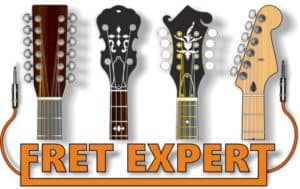When you begin learning any fretted instrument, it’s highly likely you’ll encounter issues involving fingertip discomfort or fall victim to the odd blister or two.
I’m going to offer a few pointers to prevent the worst effects of this common problem from curtailing the enjoyment of playing your ukulele. A lot of the advice will also apply to learning any other fretted instrument.
In the case of the uke, the problem can be less pronounced, due to the nylon or composite strings, but nevertheless can cause issues, if you aren’t aware of the pitfalls when you start on your musical journey.
Covered in this Article:
Why Do My Fingers Hurt When I Strum My Ukulele?
It’s a good idea to identify the cause of your pain in the first place, before applying a solution that might work. Finger pain when playing the ukulele can be caused by many things:
- Sensitive fingertips – super common, especially in beginners. This is when you have to stop playing because your fingers feel raw every time you press the string down onto the fretboard. They may also feel warm and a bit throbby! Your fingers can also look quite red and angry.
- Blisters and cuts – also common. This can really curtail your musical enjoyment for several days until the blister heals up. Cuts can also be a bar to continuing your uke sessions.
- Joint pain in the fingers. This may be linked to general physical health, rather than music-related practice sessions. If you have arthritis or a similar condition, even if it’s mild, practice sessions can exacerbate the condition.
Don’t worry though, there are many things you can do to reduce finger pain when playing your ukulele, and I’ve listed these below:
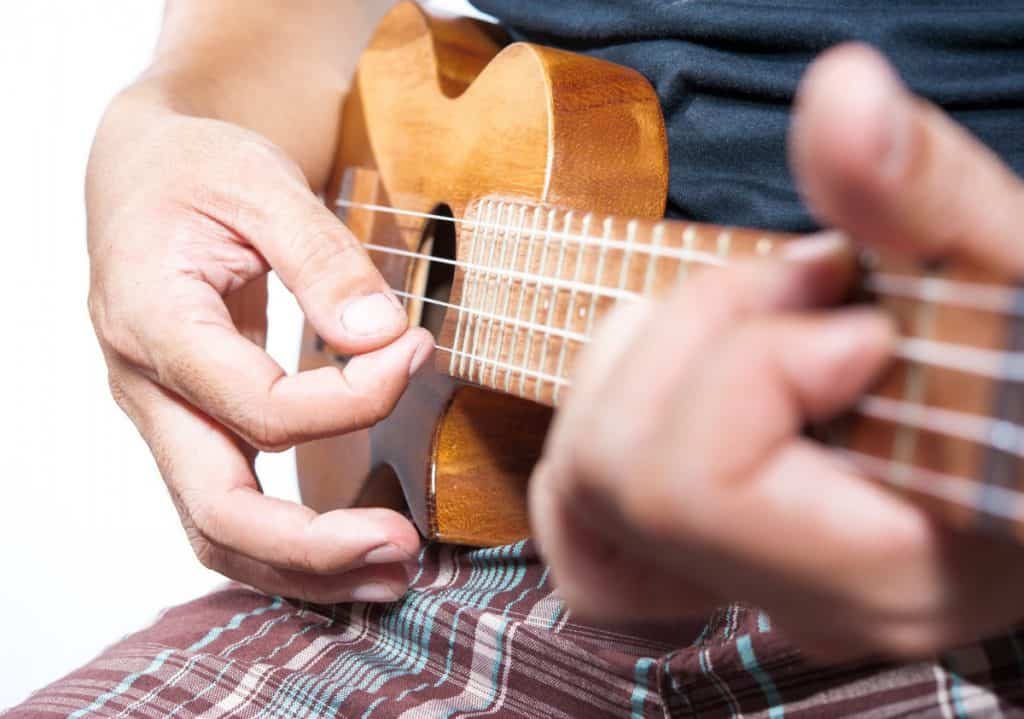
How to Prevent Finger Pain When Strumming or Picking the Ukulele
It’s probably wishful thinking that you’ll never encounter finger issues when you’re learning to play the ukulele, as most people go through elements of this in the early stages of taking up a fretted instrument. It’s perfectly normal.
Enthusiasm for your new new hobby will often override common sense, when it comes to practising.
The following list shows how to prevent finger pain when playing the ukulele. These tips should help you if you punish your sensitive digits in the course of a practice session or two!
1. Don’t Be Tempted to Overplay
The most common reason for sore fingers is overplaying. When you’re involved in the learning process, the temptation to soldier on regardless of the state of your fingers will almost certainly lead to finger pain.
The solution is very simple (in theory) – quit while you’re ahead! Try to limit yourself to a set practice time. 15 minute blocks with rests are a lot better than a sustained frontal assault on your poor fingers following an hour-long practice session. The adage ‘less is more’ really does apply to learning a new skill.
2. Embrace Calluses
Regardless of how short your practice sessions are, you will eventually reach that musical Shangri La of developing calluses on your fretting fingers and to a lesser extent, your strumming and picking fingers as well, if you pick with your fingertips.
The same advice applies whether you’re right or left handed. Developing calluses sounds counterintuitive to finger health, but embrace the calluses, because they reduce the wear on tear on the sensitive pads on your fingertips by toughening them up.
If you aren’t fancying the whole callus thing, I’m afraid you’ve probably chosen the wrong instrument or family of instruments to learn. The same thing applies to anybody learning the guitar, mandolin, violin or harp – basically, anything with strings!
3. Check the Action on Your Ukulele
Another reason for finger pain and soreness maybe due to issues with the action on your instrument. If you’re unfamiliar with the term, it simply means the height of the strings above the fretboard (or fingerboard).
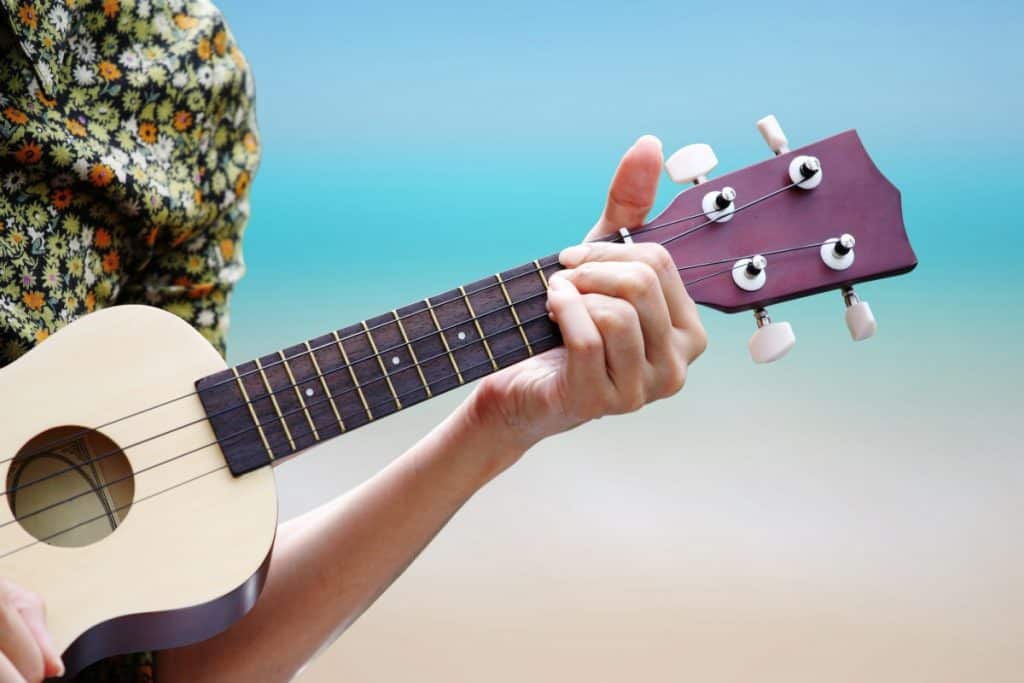
If the action is too high, you’ll more than likely have to use a lot more effort to press the string down onto the fretboard than you should need to. The problem generally manifests itself in two main areas on the fretboard – up beyond the fifth fret and right next to the nut (fret position one).
The nut is the little white or cream colored bar carrying the strings onto the headstock and tuners on your uke. If the nut is set too high, this may involve taking the ukulele along to your local music shop or looking for a local guitar/ukulele technician who can re-slot the nut or sand a little bit off the bottom of it to make it lower.
If you aren’t experienced with doing this sort of thing on your own, it’s advisable to seek outside help, rather than attempt it yourself, as a badly slotted nut will cause an unpleasant buzz from certain strings. Also if you take too much off the bottom the strings may lie too low on the fretboard, causing buzz and rendering it largely unplayable.
It’s not a terribly difficult problem to fix, but one you can easily get wrong. A bad action is a common fault with on many lower-end instruments. When in doubt, purchase your uke from a reputable dealer who may also offer a proper setup before the instrument leaves the premises.
4. Get Some Finger Protectors
An excellent solution for anyone wanting to prolong their ukulele practice sessions without the accompanying finger pain is to purchase a set of silicon or rubber fingertip protectors.
These slip over the tips of your digits and provide a comfortable cushion when you’re pressing the string down onto the fretboard. There are lots of them in almost all sizes on Amazon.
The protectors will almost always come in different sizes, but you may need to purchase a larger set if you have particularly large or small fingers, as you’ll need them to fit snugly enough so they won’t fall off or are just too small to comfortably fit.
For instance, a child may need the smallest size, suitable for a lot of adult pinkies! My only word of warning is try not to rely on them exclusively or you won’t develop the calluses needed for sustained playing sessions. Slip them on after 10-15 minutes if your fingers are showing the early signs of wear and tear.
5. Try a Guitar Glove
On a similar theme, you may find the acquisition of a guitar glove maybe beneficial if this is a serious issue for you. It can also be effective if you have other medical problems associated with fretting or picking.
These tend to come in a series of different sizes for obvious reasons (i.e. extra-small, small, medium, large and extra-large). These don’t suit everyone and can feel a bit restricting if you wear them for extended periods, but they are a good solution if other remedies don’t work. Again, there’s a wide selection on Amazon.
The glove can also be beneficial if you have a cut on one of your fingers.
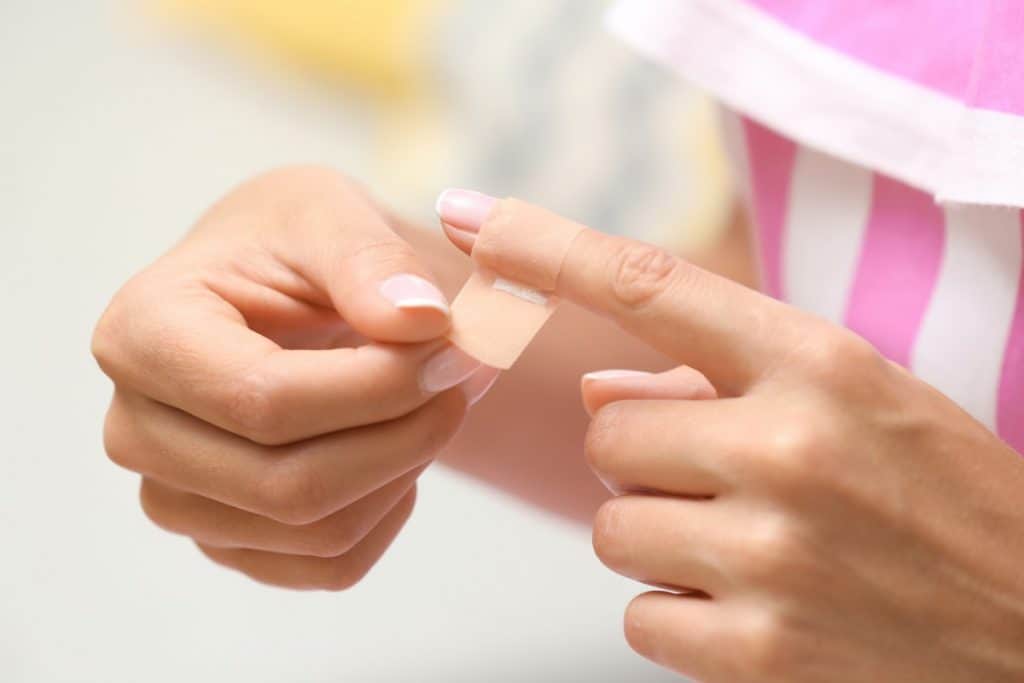
6. Treat Cuts with Liquid Band Aid… or Glue!
If you’re suffering from the aforementioned cut finger or cracked skin, then a couple of solutions can often save the day.
The first is to apply a layer of liquid bandaid/bandage solution (varying proprietary names for these). This should seal the cut and remove much of the associated pain from your finger.
You can even combine this with either the finger protectors or glove. The liquid is generally applied with a small brush which comes with the product. Something like this can be purchased for a few bucks.
On a similar theme, a lot of professional musicians who damage a finger or two during a tour or before a gig will turn to a fairly unlikely solution – superglue!
The original product was actually developed as a quick solution for sealing up wounds during a battle scenario. This provided a successful method of stemming blood loss before the injured party could then be transported to a field hospital.
Superglue’s adhesive qualities became a useful bi-product of this medical product sometime after its original use. The all-encompassing family of superglues are made up from chemicals called cyanoacrylates. I wouldn’t advise using this solution on a semi-regular basis as there are some associated minor toxicity issues, but as a temporary solution, it should be quite all right.
7. Use a Lighter Gauge String Set
If you’re playing an electric ukulele with steel strings, you may find the less forgiving metal can also contribute to sore or damaged fingers.
In a case like this, it’s a good idea to seek out a set of lighter gauge strings if you’re still at the learning stage or you’re an intermediate player who has only used nylon or composite strings up until this point.
The heavier the gauge, the more they’re likely to dig into your fingertips. The same solution applies to players learning any other steel strung fretted instrument.
If you were thinking about changing your uke stings anyway, here’s my guide to why (and when) you should change ukulele strings.
8. Vary Your Technique
Though a less common problem, you can also develop sore fingertips on your strumming and picking hand as a number of uke players like to play with the pads on their fingers.
It’s always a good idea to develop more than one playing technique if you can (although some musicians don’t deviate throughout their entire careers). When you play with your nails, this problem becomes null and void, as you’re avoiding contact with the fleshy parts of the fingers and thumb.
You can also use false nails if you’re unable to successfully grow your own. Existing nails can also be toughed up with nail varnish (clear nail varnish if you’re not comfortable with painted nails). This will help with wear and tear on the nail.
9. Strengthen Your Fingers
If your problem has more to do with reduced finger strength, it might be worth investing in a hand/finger exercise device.
These look a bit like the valves on a trumpet and can be depressed independently. Regular use should lead to significant improvement in the strength of your fingers, particularly with regard to things such as barré chords.
“Gyro balls” and other finger-strengthening devices are widely sold on Amazon, too.
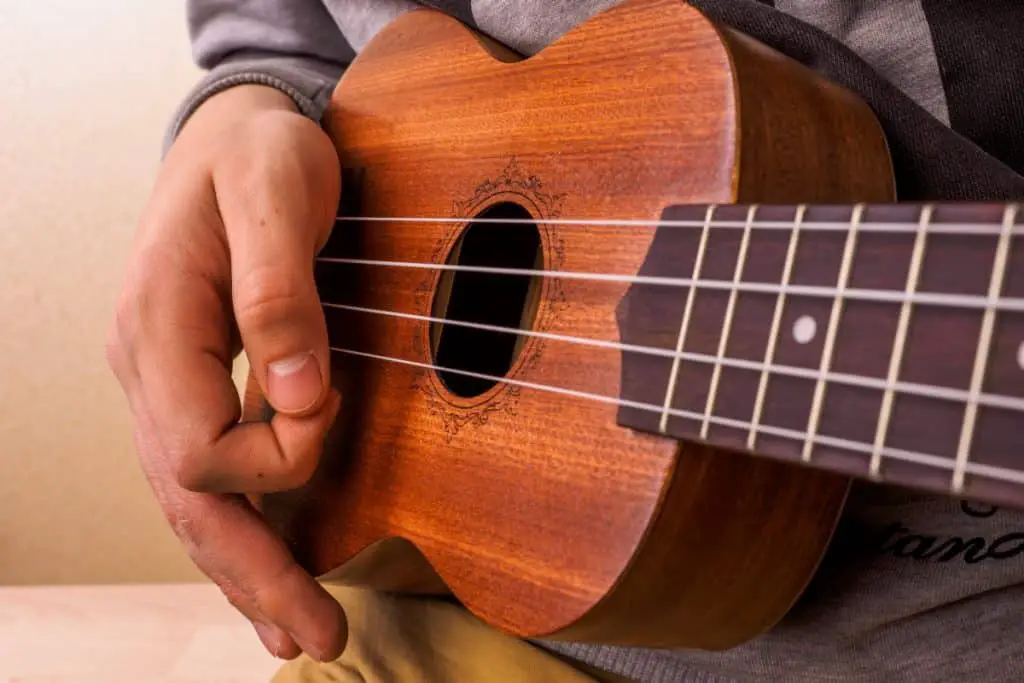
10. Tune Your Ukulele Differently
If you suffer from arthritis or a similar ailment, it’s likely that things like barré chords or chords on the first fret are going to be a major obstacle to continue playing with any degree of comfort.
One partial solution is to tune down your uke to Gb-B-Eb-Ab (a semi-tone) and put a ukulele capo on the first fret. This will make chords such as Bb or Bbm a lot less effort to play.
If you think you need a uke capo, my recommendations are here, plus a complete guide on what to look for.
Also, look for a ukulele with nice low action and comfortable neck. You might also consider changing to a uke with a little more fretboard real estate (i.e. less cramped than a soprano, for example). A baritone (D-G-B-E) or tenor (G-C-E-A or A-D-F#-B) might be a better solution to be able to continue playing.
11. Don’t Play with Open Cuts or Blisters
It’s a bad idea to ‘butch it out’ or ‘power through’ and continue playing through an injury, however minor. As much as it’s tempting to burst or prick a blister or still play with an open cut on your finger(s), this is not a good idea as:
a) It can make the finger even more sensitive
b) It can become a lot more easily infected and may lead to a more serious medical condition.
c) Playing your ukulele with an open cut also risks infection, so before you do anything else, wash the area with soap and water first and ideally stop playing until it’s properly healed up. Use an antiseptic cream as well to disinfect the area.
This is in an ideal world, so if you truly can’t avoid playing for a few days (for example, if you’re on tour), then use one of the above solutions.
So there we have it, a series of solutions to cut down or eliminate the varying causes of finger pain or damage. As a general rule of thumb, though, if your fingers start hurting, it’s always a good idea to stop playing unless you’re able to implement one of the above solutions.
The longer you carry on, the longer you’re likely to be out of action.
